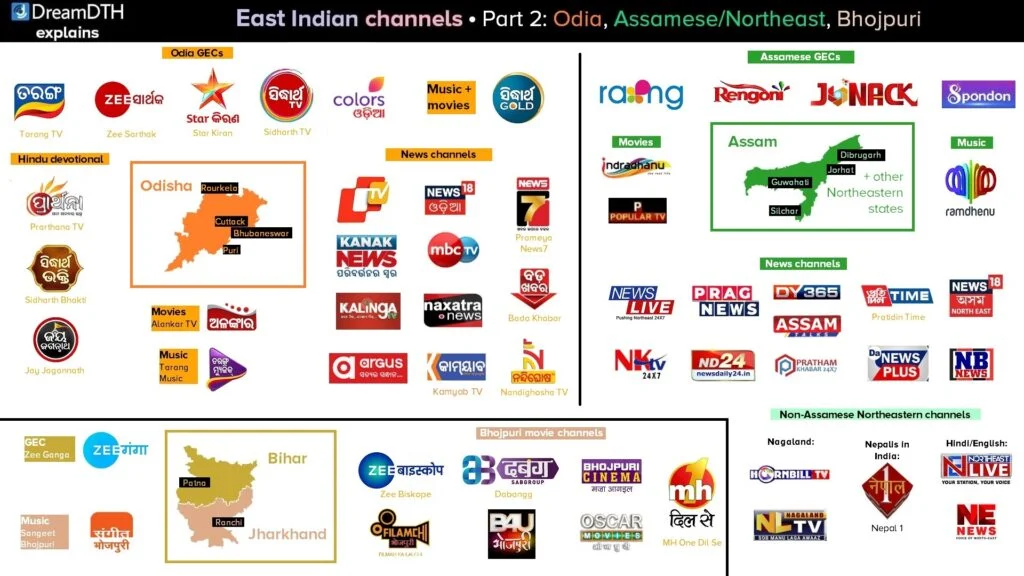Similar to the split in our articles on South Indian channels, Part 1 of our deep dive into East Indian TV channels had to be dedicated solely to Bengali channels, due to their disproportionate influence on television in not only East India but the entire country — owing to the success of Star Jalsha’s serials that are remade across Disney Star’s GECs in other languages.
Now we come to the relatively smaller languages of eastern India: Odia and Assamese, which have had a limited presence since the 2000s but recently have started to grow more — especially thanks to the proliferation of more channels in both Odisha (like Star Kiran and the Sidharth network) and Assam through several news channels — and Bhojpuri, which is overwhelmingly rural in nature and is concentrated in Bihar and Jharkhand, though several other languages (besides Hindi) are spoken in those states like Magahi and Maithili.
It is only very recently that Bhojpuri (which is mostly spoken in Bihar and Jharkhand, though the official language of those states remains Hindi) has emerged as a bona-fide regional language with its own dedicated TV channels, instead of simply being treated as a dialect of Hindi, owing to its unique rural-focused viewing nature. Also, very few Northeastern channels are non-Assamese, but they do exist nevertheless.
On this page, we cover Odia channels, with Assamese and other Northeastern channels on Page 2, and Bhojpuri channels on Page 3.
Odia channels
Odia (formerly called Oriya) is the second-largest regional language in eastern India, spoken in the state of Odisha, previously Orissa. While Odisha has a large TV-viewing population, it has lagged behind Bengali channels in terms of scale and reach, even though (unlike Assamese) national broadcasters like Zee and Viacom18 have been present here for a long time. The oldest private Odia GEC was ETV Odia, launched in 2002, before being acquired by Reliance-owned Viacom18 and rebranding to Colors Odia — but it has not been very popular in the BARC ratings chart, like Viacom18’s other regional channels.
However, the most successful Odia broadcaster is undoubtedly Odisha Television Network, part of the Ortel Communications group. Its news channel, OTV or Odisha TV, was launched in 2006 and has remained the leading Odia news channel ever since, while its GEC Tarang TV has almost always been the leader since its launch in 2008 — much like Pride East Entertainments in Assam, whose News Live and Rang channels dominate the Assamese news and GEC spaces, respectively. Tarang Music was launched in 2009 and the Hindu devotional channel Prarthana TV in 2010, followed by the movie channel Alankar TV in 2015, which has a focus on traditional jatra performances. With all these channels — plus the 2022 launch of Tarang HD (which is yet to be added by DTH operators) — Ortel has cemented its position as the biggest broadcaster in Odisha, much like Punjab’s PTC Network.
Meanwhile, the other big success story in Odia TV was launched in 2010 as Sarthak TV, and acquired by the Zee network in 2015, which took the opportunity to rebrand it to Zee Sarthak during the broadcaster’s mega-rebrand in October 2017 covering all channels and properties. Zee Sarthak has typically been the number two channel in Odisha after Tarang TV, and it has not planned for an HD feed nor does it have any complementary movie channels, unlike Zee’s other regional GECs — except Zee Punjabi, which is similarly solitary.
The Sidharth network (run by Sitaram Agrawal, the original owner of Sarthak TV before its acquisition by Zee) started operations in May 2021 with three channels: Sidharth TV (GEC), Sidharth Gold (movies and music) and Sidharth Bhakti (Hindu devotional), while another Hindu channel, Jay Jagannath, was launched in 2022. The Sambad group — which runs the Sambad newspaper and the Kanak News channel — also launched the free-to-air Manjari TV in February 2020, but its satellite feed shut down after two years and it turned into a digital-only channel.
In contrast, when Disney Star decided to expand beyond its comfort zone of the ‘Big Six’ regional languages (the four Southern languages plus Bengali and Marathi) on 6 June 2022, it launched its own channel from scratch — Star Kiran — much like the launches of Star Jalsha and Star Pravah in 2008, instead of acquiring an existing one as it had done with Star Vijay (Tamil) and the Asianet, Suvarna and Maa channels in Malayalam, Kannada and Telugu. Importantly, Star Kiran HD was the first-ever Odia satellite HD channel, but DTHs started adding it only in late 2023. Unfortunately, due to the lack of promotions and a proper strategy, Star Kiran has been a complete disaster in the ratings chart, not even being able to enter the top 5 channels in Odisha (with only Colors Odia doing worse) — an anomaly for Star, whose regional channels are highly successful otherwise.
These aside, there are a number of independent Odia news channels like Kalinga TV, MBC TV, Naxatra News, Kamyab TV, Prameya News7 and more recently Nandighosha TV (formerly Focus Odisha), Argus News and Bada Khabar, with News18 currently being the only national broadcaster with an Odia satellite news channel. Zee’s Odia satellite news channel, Zee Odisha (formerly Zee Kalinga News), was shuttered in March 2022 and converted into the digital-only Zee Odisha News, with Zee Delhi NCR Haryana being launched in its place. Almost all Odia channels are based out of the state capital of Bhubaneswar or its twin city, Cuttack, and none of them are available overseas, since not that many Odia people live outside India compared to Bengalis, South Indians or Punjabis with their big diasporas in several parts of the globe.
Table of major Odia broadcasters
| Broadcaster↓ Genre→ | GEC | Movies | Music | News | Hindu | Total |
|---|---|---|---|---|---|---|
| Ortel Communications | Tarang TV (HD)1 | Alankar TV | Tarang Music | OTV (Odisha TV) | Prarthana TV | 6 |
| Disney Star | Star Kiran (HD) | 2 | ||||
| Zee2 | Zee Sarthak | 1 | ||||
| Viacom18/Network18 | Colors Odia | News18 Odia | 2 | |||
| Sidharth | Sidharth TV | Sidharth Gold | Sidharth Bhakti, Jay Jagannath | 4 |
Independent Odia channels and other channels from national broadcasters
- GEC: Manjari TV (Sambad group); shut down in 2022 on satellite, available digitally.
- Government: DD Odia
- News: Kalinga TV, MBC TV, Kanak News (Sambad group), Kamyab TV, Prameya News7, Naxatra News, Argus News, Bada Khabar
Notes:
1Tarang HD is not currently available on DTH platforms but is confined to Ortel Cable, its sister company. However it is a satellite HD channel — and so can be added by DTHs in the future — unlike the HD channels from Punjab’s PTC Network, which are non-satellite channels and are exclusively available on its sister concern Fastway Cable.
2Zee Odisha (formerly Zee Kalinga News) ceased satellite broadcasting in March 2022 and was replaced by a digital-only channel, Zee Odisha News, along with the launch of Zee Delhi NCR Haryana.
As is visible above, Odia is the only East Indian language with any devotional channels — which is not too surprising since it is the home of the famous Puri Jagannath temple, one of the leading Hindu pilgrimage destinations, much like the Venkateswara temple in Tirupati, Andhra Pradesh. As such, there are not one but three Hindu devotional channels in Odia: Ortel’s Prarthana TV, the oldest of the lot, and two from the newbie Sidharth network — Sidharth Bhakti, launched along with Sidharth TV and Sidharth Gold in May 2021, and Jay Jagannath, launched in June 2022 and dedicated to Lord Jagannath.
Moreover, Odia has very few movie and music channels: Ortel’s Alankar TV and Tarang Music are dedicated to the respective genres, while Sidharth Gold has a blend of both, and neither Star nor Zee nor Viacom18 has yet planned for any Odia movie channels. For a brief time, the Odia version of ETV Bal Bharat was the only kids’ channel in the language, but it lasted barely a few months before being axed in early 2022 along with all non-South Indian ETV Bal Bharat channels — even though the main ETV Bal Bharat SD and HD channels still carry Odia and 11 other audio feeds.
Now we see how Star Kiran, despite Disney Star’s track record of success in regional languages, has not lived up to expectations — even with an HD feed, a lineup of serials and movies and a beautiful tribal art-inspired graphics package to boot — but its presence is nevertheless necessary for the growth of the Odia TV industry.
Despite Star Kiran’s ratings woes, it is a necessary breath of fresh air for Odia TV
It is no exaggeration to say that Star Kiran, after the first year of its operations, is an utter failure. Most new regional GECs take time to stabilise, accumulate a market share and build trust with viewers — and none has been more successful than Zee Keralam, Zee’s Malayalam GEC, which was launched in November 2018 and turned five years old recently, having managed to secure the second spot for itself after Disney Star’s Asianet. While other such launches — like Colors Tamil, Sony Marathi, Sun Bangla and Sun Marathi — were not quite as successful, they have still managed to garner some viewership and brand equity. (Sony Marathi, in particular, has banked heavily on reality shows, much like the Hindi flagship, Sony TV — but it is also the only one of these to have abandoned plans for launching an HD feed!)
However, those channels were entering in the presence of cut-throat competition from market leaders, particularly in Bengali and Marathi, and they still managed to establish themselves in the hearts of viewers. In contrast, Star Kiran had a golden opportunity to make a big splash in a large but rather underdeveloped state with no HD channels so far. With the audience largely loyal to Tarang and Zee Sarthak, Star Kiran could very well have gone ahead and shaken up the Odia TV market like Zee Keralam did. And not for want of trying, since it had a slate of new serials (based on the tried-and-tested formula of remaking Star Jalsha originals) as well as movie premieres to bolster its programming lineup, despite having no reality shows whatsoever — something that fellow newcomer Sidharth TV has focused on extensively.

Unfortunately for Star Kiran, the exact opposite happened, and there were some (inadequate) promotions on social media platforms, nor were the serials at launch particularly well received. As a result, it never rose above the fifth position in the BARC top 5 Odia channel ratings at best, and even this was a rarity. Within a few months, the remade serials were taken off air and replaced with dubs of Hindi serials. Arguably the same fate has befallen another new Star regional channel: the Marathi movie channel Pravah Picture, launched a few weeks before Star Kiran in May 2022. Instead of the promised lineup of continuous Sunday premieres, it has since regressed into showing old Star Pravah serials due to the lack of a cohesive strategy — even as Star Pravah has been the emperor of Marathi TV for years.
And yet credit must be given to Star Kiran where it is due: if not for Disney Star’s bold decision to enter a smaller regional market, Odia television may have had to wait even longer to get its first HD channels. Star Kiran was available in HD from day one, but no TV platforms — DTH or cable — added the HD feed for well over a year, and it was only in August 2023 that Dish TV added a number of new Disney Star HD channels, while Tata Play had its own bumper addition at the end of October (including Star Kiran HD and Pravah Picture HD) which greatly helped to increase the visibility of these channels.
Still, all is not lost for Star Kiran, as it is only early days, and with some effort and direction, it has the potential to make it as big in Odia TV in the coming years as Zee Keralam or Star’s own Star Maa (in Telugu) did. Hopefully, the benefits that Star Kiran HD has indirectly brought about will also translate into Zee Sarthak, at least, launching an HD version, in addition to Tarang expanding the distribution of its own HD feed.
On Page 2 we turn to Assamese and other Northeast channels, and on Page 3 we cover Bhojpuri channels, which have a much lower profile and viewership, but it is nevertheless necessary to give them their due space.









No replies yet
Loading new replies...
Join the full discussion at the DreamDTH Forums →